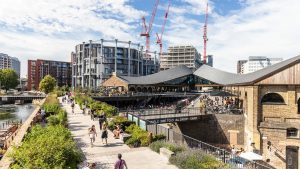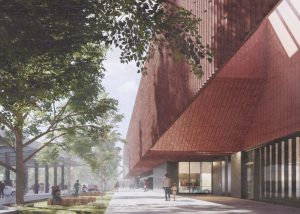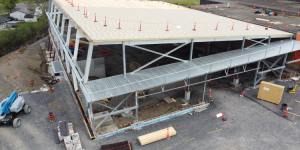Kings Cross in central London is one the best known areas of Britain.
With a 200-year history spanning all aspects of urban use, its checkered past is now largely behind it. Today, Kings Cross represents an example of the potential for inner city revitalization to the highest 21st century standards.
The history of the Kings Cross district rings similar to those of many major cities in Europe and North America. In London’s case, back in 1820, with the completion of the Regent’s Canal, Kings Cross became an important industrial and transport hub linking London to the cities to the north. Consequently, buildings across its 67 acres were brutal and purpose-built.
A post Second World War decline witnessed the decay of Kings Cross. It became dominated by the abandoned buildings, railway sidings and warehouses of the past, separated in many instances by empty contaminated lots. Although Kings Cross gained a reputation in the 1990s as a hotspot for nightlife and artists, crime and unemployment were major issues.
Plans in the 1980s and early ‘90s to redevelop Kings Cross fell through. However, prospects for Kings Cross changed dramatically in 1996 with the decision to move the Channel Tunnel Rail Link from Waterloo to St. Pancras in order to facilitate regeneration in east London. The area’s joint landowners, London & Continental Railways Limited and Excel (now DHL) then decided to redevelop the property.
This triggered a series of positive events over the next few years that demonstrated, as Rowan Moore of the says, “the idea that market forces, wisely guided by light-touch government, can be a power for good.”
In 2001, Related Argent, a joint venture between U.S. developer Related Companies and U.K.-based developer Argent, was brought onboard as the development partner. Several years of studies and consultations then took place, leading to a plan prepared by��Allies and Morrison, Porphyrios Associates and Townshend Landscape Architects. ��
In 2006, outline planning permission was granted for the construction of 50 new buildings, the creation of 20 new streets, 10 new major public spaces and up to 2,000 homes. The restoration and refurbishment of about 20 historic buildings and structures in Kings Cross was viewed critical to maintaining the area’s character.
In 2008, the property ownership team formed a joint partnership to create Kings Cross Central Limited Partnership (KCCLP) as the area’s owner. This consolidation of ownership with a long-term view gave the revitalization plan the corporate structure needed to move forward as a single entity.
The result today is an exciting, safe and vibrant district that maximizes Kings Cross’ irregular layout of streets, squares and historic structures, together with the canal that winds through the area.

“Over the past 20 years, what was an underused industrial site has been transformed and rejuvenated with new streets, squares and parks, homes, shops, offices, galleries, bars, restaurants, schools, and even a university,” proclaims the . “Kings Cross is now a much-loved part of London and a popular destination for locals and visitors from further afield.”
Moore describes Kings Cross as, “a place where you are ‘invited’ through from one space to another, where all the parts interconnect, and where buildings are less important than the spaces between them, and where the boundaries with surrounding areas are blurred.”
The strong sense of community is also reinforced by the 1,700 new housing units, 36 per cent of which are affordable. The area also boasts a thriving business community that includes leading commercial tenants such as Meta, Google, Universal and Nike. Overall, the number of firms moving into the area roughly doubled to 800 between 2010 and 2021. Estimated office rents in Kings Cross have also more than doubled over the same period.
Equally impressive has been the transformation of Kings Cross into a certified CarbonNeutral® Development.
“The Kings Cross neighbourhood is powered entirely by green gas and electricity – meaning all the electricity and gas that heats, cools and powers the neighbourhood comes from renewable sources,” the area’s website . ��
This has prevented an estimated 19,729 tonnes of CO₂ from being released into the atmosphere annually.
Equally important to KCCLP’s efforts to maximize operational energy efficiency is the use of climate-smart tech and energy-saving behaviours. Overall, KCCLP expects to improve the operational efficiency of the office buildings by 66 per cent.
This high-tech integration presented challenges when dealing with the many older, historical buildings.
As Jack Sibley, head of proptech and innovation at Related Argent told , “We didn’t have the option to strip many of the buildings back to install sensors for the BMS systems.”
Instead, Related Argent used what Sibley called “LoRaWAN backbones” so they could add and continue to improve the building monitoring systems.
Kings Cross has not overlooked embodied carbons, even those associated with the construction of the area’s original buildings. These are offset using “.”
The net result is that the Kings Cross revitalization can be viewed as a huge success and an example of urban renewal at its finest where the private sector and local planning combine their efforts in order to reduce risks.
��John Bleasby is a freelance writer. Send comments and Climate and ������ion column ideas to editor@dailycommercialnews.com.











Recent Comments
comments for this post are closed